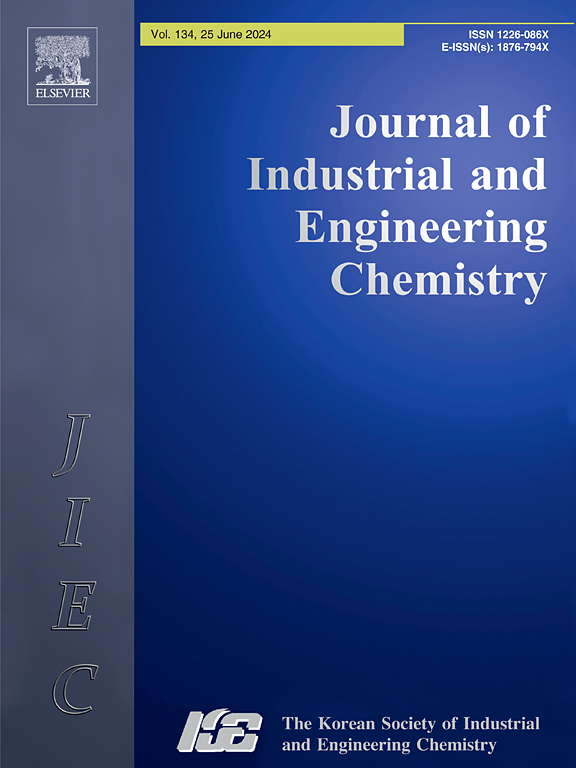Fe(III) and Zr(IV) intercalated titanate nanotubes: A singular solution for efficient remediation of five toxic heavy metal ions from water
IF 5.9
3区 工程技术
Q1 CHEMISTRY, MULTIDISCIPLINARY
Journal of Industrial and Engineering Chemistry
Pub Date : 2024-11-20
DOI:10.1016/j.jiec.2024.11.040
引用次数: 0
Abstract
Industrial wastewater is a major source of toxic contaminants, including hazardous heavy metal ions (HMIs). In this research, Fe(III) and Zr(IV) Intercalated Titanate Nanotubes (FeZr-TNT), a novel material, was engineered to adsorb both cationic and anionic HMIs individually, as well as simultaneously when multiple ions are present in water. Batch adsorption experiments demonstrated that the material is applicable across a broad pH range (pH 2 to 8), with high efficiency and rapid kinetics, making FeZr-TNT particularly suitable for treating groundwater and industrial wastewater. FeZr-TNT exhibited high adsorption capacities (Qmax) for various HMIs: 69 mg/g for Cr(VI), 99.5 mg/g for Pb(II), 166.8 mg/g for As(III), 222.2 mg/g for As(V), and an exceptional 4125.7 mg/g for Hg(II). Notably, it exhibited an unprecedented efficiency for Hg(II), surpassing previously reported values of Qmax for Hg(II) highlighting its exceptional performance. Material characterization of pristine and HMI adsorbed FeZr-TNTs provided insights into its unique structural properties, likely contributing to its high adsorption for multiple HMIs. These properties including the abundance of surface hydroxyl groups, suggest that FeZr-TNT offers highly effective active sites for capturing diverse contaminants, underscoring its potential as an advanced adsorbent for environmental remediation.

Fe(III)和Zr(IV)插层钛酸盐纳米管:一种有效修复水中五种有毒重金属离子的单一溶液
工业废水是有毒污染物的主要来源,包括有害重金属离子(hmi)。在这项研究中,Fe(III)和Zr(IV)插层钛酸盐纳米管(FeZr-TNT)是一种新型材料,可以分别吸附阳离子和阴离子的hmi,也可以在水中存在多种离子时同时吸附。批吸附实验表明,该材料适用于较宽的pH范围(pH 2 ~ 8),效率高,动力学快,特别适用于处理地下水和工业废水。FeZr-TNT对各种hmi具有较高的吸附能力(Qmax):对Cr(VI)的吸附量为69 mg/g,对Pb(II)的吸附量为99.5 mg/g,对As(III)的吸附量为166.8 mg/g,对As(V)的吸附量为222.2 mg/g,对Hg(II)的吸附量为4125.7 mg/g。值得注意的是,它对Hg(II)表现出前所未有的效率,超过了先前报道的Hg(II)的Qmax值,突出了其卓越的性能。原始和HMI吸附fezr - tnt的材料特性提供了对其独特结构特性的见解,可能有助于其对多种HMI的高吸附。这些特性包括丰富的表面羟基,表明FeZr-TNT为捕获各种污染物提供了高效的活性位点,强调了其作为环境修复的高级吸附剂的潜力。
本文章由计算机程序翻译,如有差异,请以英文原文为准。
求助全文
约1分钟内获得全文
求助全文
来源期刊
CiteScore
10.40
自引率
6.60%
发文量
639
审稿时长
29 days
期刊介绍:
Journal of Industrial and Engineering Chemistry is published monthly in English by the Korean Society of Industrial and Engineering Chemistry. JIEC brings together multidisciplinary interests in one journal and is to disseminate information on all aspects of research and development in industrial and engineering chemistry. Contributions in the form of research articles, short communications, notes and reviews are considered for publication. The editors welcome original contributions that have not been and are not to be published elsewhere. Instruction to authors and a manuscript submissions form are printed at the end of each issue. Bulk reprints of individual articles can be ordered. This publication is partially supported by Korea Research Foundation and the Korean Federation of Science and Technology Societies.

 求助内容:
求助内容: 应助结果提醒方式:
应助结果提醒方式:


